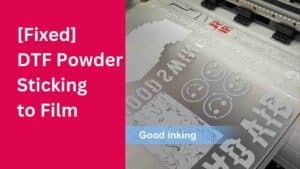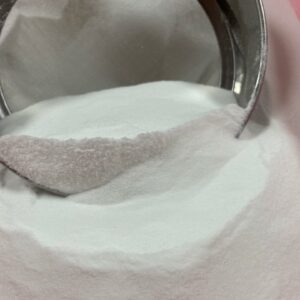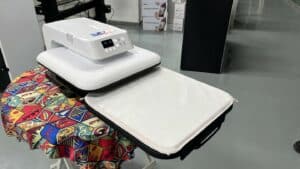Have you struggled with DTF powder sticking to film during printing? If so, you’re not alone. This common issue may result in poor print quality and material waste, costing you time and money. This article will explain why powder sticks to film in DTF printing and how to avoid it. These methods will help you make high-quality DTF prints and prevent powder clinging to film, whether you’re a beginner or a master. So let’s get started and look at how to solve this typical problem with DTF printing.

Why is DTF powder sticking to film?
Why is your powder sticking all over the film? It happens when the powder sticks to the film rather than transferring to the substrate, resulting in an incomplete or fuzzy picture.
DTF film and powder sticking may have a big effect. It can waste paper and time because you might have to print the job again or change the settings on the printer. Also, it might affect the quality of the final print, resulting in an unprofessional look and perhaps unsatisfied clients.
In DTF printing, powder sticks on film for numerous reasons:
1. Air humidity
DTF printing powder sticks to film due to humidity. It can cause issues with the transfer process when the humidity is too low or too high, causing the powder to adhere to the film rather than transfer to the substrate.
Low humidity makes the air dry, and because there isn’t enough moisture in the air, the powder doesn’t transfer properly. Powder clumps in dry conditions, making it harder to transfer to the substrate. Static electricity on the film from low humidity can attract the powder and prevent it from transferring.
On the other hand, very high air humidity causes the atmosphere to become overly moist and humid. Moisture can make powder clump and make it hard to transfer. High humidity can also cause the film’s adhesive layer to cling, preventing the powder from migrating to the substrate.
2. Excessive tackiness of the adhesive layer on the film

The adhesive layer is crucial for retaining the powder onto the film until the printing process transfers it to the substrate. If the adhesive layer is very sticky, the powder may adhere to the film rather than transfer to the substrate.
Excessive tackiness of the adhesive layer on the film can result from a number of circumstances, such as:
- Adhesive type: The degree of tackiness might vary between different adhesive kinds. Powder can stick if the adhesive is too sticky for the powder or printing environment.
- Adhesive thickness: The film’s adhesive layer thickness affects its tackiness. The powder will stick to the film if the adhesive layer is too thick.
- Temperature: The tackiness of the adhesive layer is impacted by the temperature of the printing environment. High temperatures can make the adhesive layer sticky, causing powder to stick.
In DTF printing, the right adhesive for the powder and printing environment prevents excessive tackiness and powder clinging to film. It’s also vital to ensure the adhesive layer’s thickness is suitable for printing conditions and the temperature is within the specified range. By tweaking these variables, you can get the adhesive layer’s tackiness level just perfect and stop powder from adhering to the film.
3. Coating density of film and fineness of powder

Two critical elements that affect the transfer procedure and help powder adhere to film in DTF printing are the coating density of the film and the fineness of the powder.
- Film Coating Density: The film’s coating density describes the thickness of the adhesive layer that is applied to the film. The powder may not stick to the film or transfer to the substrate during printing if the coating density is too low. On the other hand, if the coating density is too high, the adhesive layer can become too thick. This can cause the powder to stick to the film instead of the substrate if the tackiness is too high.
- Fineness of Powder: The size of the powder’s particles is referred to as the powder’s fineness. If the powder particles are too big, they may not attach correctly to the film’s adhesive layer, resulting in uneven printing or powder sticking to the film instead of the substrates. If the powder particles are excessively tiny, they may agglomerate, making them hard to transfer to the substrate.
DTF printing requires the right coating density and powder fineness to avoid powder adhering to film. The coating density must be tailored for the adhesive and powder being used, and it is crucial that the powder particles be neither too big nor too small. The right coating density and powder fineness enable powder adherence and transmission, resulting in high-quality prints without powder clinging to film.
4. Printing speed and front and rear heating
DTF printing powder adherence to film is also affected by printing speed and front and back heating.
- Printing Speed: The printing speed impacts the transfer process. If it is too high, the powder will disperse or may not properly bind to the adhesive layer on the film. Optimizing printing speed for the glue, powder, and printing environment prevents this.
- Front and Back Heating: The printing equipment’s heating components may be adjusted to optimize transfer. If the front and back heating is not adjusted for the printing circumstances, the adhesive layer might become too sticky, attaching powder to the film. Adjusting front and back heating prevents powder from clinging to the film and ensures a high-quality transfer.
5. The powder chamber and the film route from the printer are dirty
Any dust or debris on the film or in the powder chamber might cause the powder to adhere to the film instead of the substrate during printing.
To prevent this problem, keep the film path and powder chamber clean and debris-free. Dust and dirt may attach to film if printing equipment isn’t cleaned regularly. High-quality films and powders that don’t create dust are also necessary.
The film passage and powder chamber should be checked before each printing job in addition to routine maintenance and cleaning. Clean the film path and powder chamber to prevent powder sticking to the film and ensure high-quality prints.
6. The powder is moist while shaking

If the powder is damp during the shaking process, it can cause clumping and sticking to the film during the transfer process. This could lead to shoddy printing and waste of resources.
Store DTF powder in a cool, dry area and use it within its shelf life to prevent dampness. Avoid exposing the powder to moisture or excessive humidity, which can clump or wet it.
Try spreading the powder out on a flat surface and let it air dry for a few minutes if you find that it became moist during the shaking procedure. Dehumidifiers can help dry powder before use.
Also, it’s crucial to thoroughly shake the powder before using it to make sure it is dispersed evenly and is free of clumps. Sieves or mesh strainers help break up clumps.
Solutions to Stop Film & DTF Powder Bonding
1. Adjusting temperature and humidity levels
Temperature and humidity impact the transfer process and cause powder to adhere to the film. Changing the environment’s humidity and temperature will help avoid powder from adhering to film during DTF printing.
Controlling the printing environment helps optimum temperature and humidity. Track and control humidity and temperature using a monitor. Generally, the ideal humidity range for DTF printing is between 50% and 60%, while the ideal (room) temperature range is between 20 and 25°C (68 and 77°F). For DTF heat press settings, the optimum range is normally between 150 and 165 °C (302 and 329 °F) .
2. Using high-quality films and powders
High-quality films and powders avoid powder adhering to film in DTF printing. They are often less prone to develop dust or debris, which might result in powder adhering to the film.
Use films and powders intended for DTF printing and tested for quality and consistency. To maintain optimum performance, it’s also crucial to adhere to the manufacturer’s use and storage recommendations.
3. Cleaning the film path and powder chamber
A filthy film route or powder chamber might cause powder to cling to the film instead of the substrate. It’s crucial to maintain the powder chamber and film route clean to avoid this problem.
Frequent upkeep and cleaning of the printing machinery can help avoid dust and debris accumulation, which can cause powder to adhere to the film. Also, it’s critical to check the film route and powder chamber for dirt and impurities before each printing session.
4. Optimizing printer settings

Adjusting printer settings could prevent DTF powder adhering to film. Printer settings can impact various aspects of the printing process, including print head height, printing speed, temperature, and ink saturation.
Optimizing these parameters for the adhesive, powder, and printing environment ensures appropriate powder adhesion and transfer, preventing powder adhering to the film.
5. Using anti-static tools
Use anti-static equipment to avoid film & powder attachment in DTF printing. The powder may cling to the film instead of transferring to the substrate if static charge builds up on the film and attracts it.
To neutralize the film’s static charge, use an anti-static bar or ionizing fan. These appliances produce ions to neutralize static charge and prevent powder from clinging to film.
6. Using a tack-reducing agent
To stop powder from clinging to film while using DTF printing, another option is to use a tack-reducing agent. A liquid solution known as a “tack-reducing agent” is sprayed to the film prior to printing in order to lessen how tacky the adhesive layer is.
The transfer procedure and powder adherence to the film are improved by lowering the adhesive layer’s tackiness. Tack-reducing chemicals are available from DTF printing equipment and supply vendors.
Overusing a tack-reducing compound may diminish powder adherence with the substrate, so follow the manufacturer’s guidelines.
7. Use a Humidifier

When using DTF printing, static electricity may be a big factor in the powder binding to the film. Humidifiers and static removal rods minimise static electricity.
Increasing printing speed reduces white ink production and prevents powder clinging to the film. Slowing down the printing speed reduces the quantity of white ink on the film, preventing powder clumping and sticking.
Finding the ideal balance between speed and quality is crucial since changing the printing speed may also change how the print turns out.
Best Practices You Should Follow
Want to get rid of the DTF film and powder sticking problem permanently? It’s crucial to adhere to a few best practises that can assist improve the transfer process and ensure high-quality prints. Best practises to follow to are listed below:
- Printer maintenance and cleaning: Proper printer maintenance and cleaning helps avoid powder adhering to film. This include cleaning the print head, inspecting for blocked nozzles, and changing any worn-out or broken components.
- Proper storage of film and powder: Properly storing film and powder prevents moisture and other impurities from compromising print quality. Use the film and powder within the specified shelf life and keep them in a cool, dry location.
- Proper handling of film during printing: Proper handling of film during printing is essential to prevent contamination, wrinkling, or other issues that can cause powder sticking to the film. Always use clean hands while handling the film, and use gloves if required.
- Conducting a test print before starting the actual job: Doing a test print before beginning the real work might help you find any problems that could be causing the powder to adhere to the film. This gives you the opportunity to refine the transfer procedure before beginning the real work.
- Observing manufacturer’s instructions: While utilising DTF printing tools and materials, it’s critical to comply to the manufacturer’s instructions. This involves utilising the right film, powder, settings, and manufacturer-recommended equipment and solutions.
You can prevent powder from attaching to film in DTF printing by following these recommended practices, which will also ensure consistently excellent prints.
How to solve the problem of powder stick to the unprinted area of film?
Excess powder on the film is one of the most frequent reasons why powder adheres to the region of the film that is not printed. To avoid this, use enough powder and evenly sprinkle it on the film. To disperse the powder uniformly, you may either use a powder shaker machine or do it by hand.
Finding the right pressure and temperature settings will ensure that the powder sticks solely to the film’s printed region. To ensure the powder sticks exclusively to the printed area, adjust the printing speed.
Conclusion
In printing, DTF powder sticking to film may be a tedious and expensive issue. But, understanding the reasons of powder sticking and using the right remedies can avoid it and produce high-quality prints.
Controlling temperature and humidity, employing anti-static instruments, and utilising tack-reducing compounds helps prevent powder from clinging to film. Following best practices including printer maintenance and cleaning, film and powder storage, and test printing before commencing the project can also help eliminate this problem.
FAQs
You can see uneven prints or too much powder clinging to the film. It is advised to test the humidity using a hygrometer and make adjustments as necessary.
No, in order to get the best results, it’s crucial to use the powder that’s been recommended for your particular printer and film combination.
To avoid powder or adhesive accumulation, clean your equipment after each usage.
Indeed, changing the printing speed sometimes works well. To avoid further problems, it is crucial to make sure that the speed is neither too high or low.
Keep DTF film and powder cold and dry. Use them before they expire too.
Too much powder might cause the film’s unprinted portions to stick. Use enough powder and spread it evenly across the film.
Certain films are incompatible with tack-reducing chemicals. For compatibility information, it is crucial to check with the manufacturer or supplier.

Ashley Wang is a skilled sales manager with knowledge in DTF printing. She presently works for ShenLan Digital, a reputable DTF printer maker. Ashley is the best person to offer advice on selecting the most suitable DTF printer because she has tested a lot of them. She launched DTFPrinterSchool to educate individuals and organizations about DTF printing technology, providing her expertise and observations on the most recent advancements in the sector. Ashley is an invaluable resource for businesses and individuals wishing to invest in DTF printing technology because of her expertise and experience in the industry.
